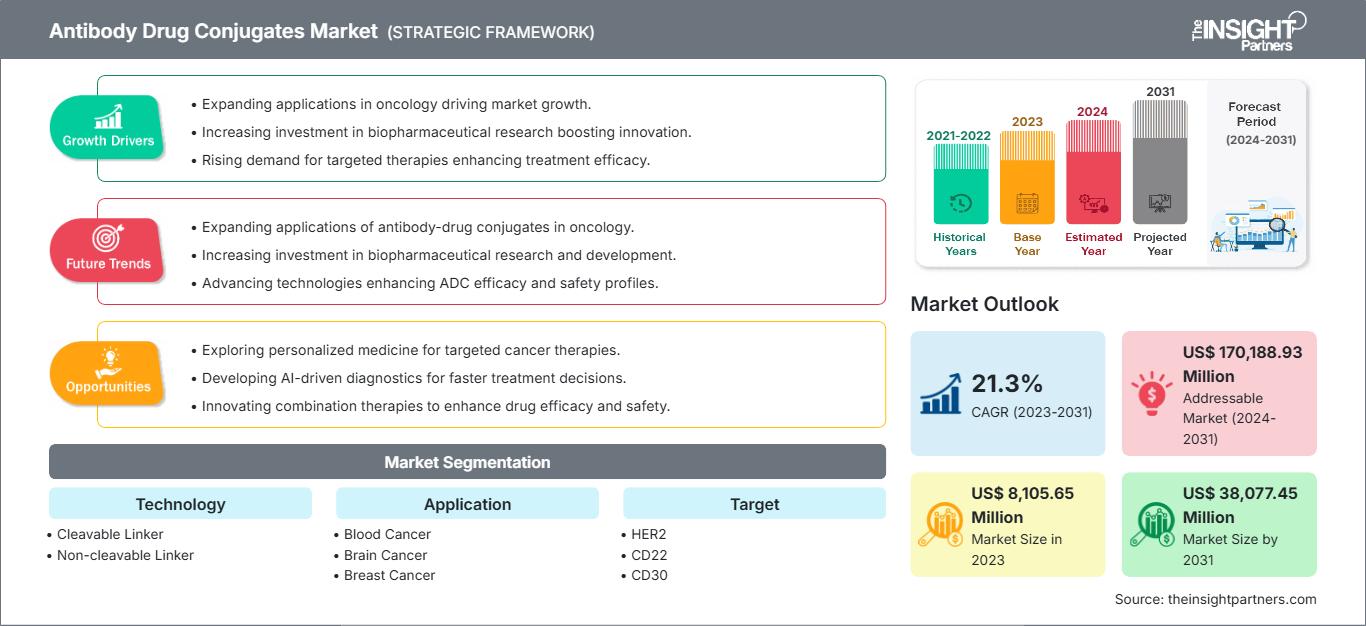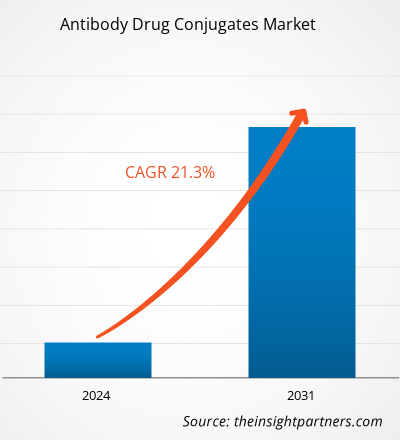抗体药物偶联物市场规模预计将从2023年的81.0565亿美元增至2031年的380.7745亿美元。预计该市场在2023年至2031年期间的复合年增长率将达到21.3%。不断扩大的临床试验渠道可能会在未来几年为市场带来新的趋势。
抗体药物偶联物市场分析
监管格局已不断发展,以支持加快抗体药物偶联物的审批速度。监管机构越来越认识到这些疗法的独特优势,从而简化了有前景的候选药物的审批流程。在上市时间可能显著影响产品商业成功的市场中,这种转变至关重要。因此,随着获批抗体-药物偶联物的供应增加、研发投入增加、获批适应症的扩大、支持性监管框架的完善以及对靶向生物疗法的需求不断增长,推动了市场的增长。随着对更有效、更有针对性的治疗方案的需求不断增长,制药公司和生物技术公司正在将大量资源投入到抗体-药物偶联物的研发中。辉瑞公司、基因泰克、吉利德科学和许多其他制药公司都在抗体-药物偶联物开发项目上投入了大量资金。据 Novotech 称,2018 年至 2022 年,全球有超过 900 个由行业发起并正在进行的抗体-药物偶联物试验;亚太地区占这些试验的三分之一以上。除美国和欧洲外,中国大陆、韩国、澳大利亚、日本和台湾是经常参与的亚洲地区,其中近 60% 的亚洲试验由中国大陆牵头。因此,强劲的研发投入预计将在未来为抗体-药物偶联物市场带来重大趋势。
抗体-药物偶联物市场概览
在靶向治疗的进步和肿瘤学投资不断增加的推动下,抗体-药物偶联物市场正在经历强劲增长。整合连接体化学和有效载荷开发等创新技术对于提高抗体-药物偶联物的性能至关重要。此外,在针对自身免疫性疾病以及癌症以外的其他疾病的临床试验中,ADC 候选药物的不断扩大预示着其光明的未来。总体而言,ADC 市场有望大幅扩张,这反映了现代医学向更精准、更有效的治疗方案转变。由于严重的眼部毒性担忧,美国食品药品监督管理局 (FDA) 于 2022 年 12 月撤回了 Blenrep (belantamab mafodotin),这严重影响了多发性骨髓瘤的治疗格局。总体而言,该产品的损失可能会阻碍肿瘤学领域的创新和投资,从而影响长期增长前景。
目前,几种抗体-药物偶联物正处于 3 期试验阶段,重点是验证其在更大患者群体中的有效性和安全性。2028 年前,处于 3 期试验阶段的 ADC 的上市将显著重塑肿瘤学格局,为患者提供创新的治疗选择,并可能增加市场收入。
自定义此报告以满足您的要求
您将免费获得任何报告的定制,包括本报告的部分内容,或国家级分析、Excel 数据包,以及为初创企业和大学提供超值优惠和折扣
抗体药物偶联物市场: 战略洞察

- 获取本报告的主要市场趋势。这个免费样本将包括数据分析,从市场趋势到估计和预测。
您将免费获得任何报告的定制,包括本报告的部分内容,或国家级分析、Excel 数据包,以及为初创企业和大学提供超值优惠和折扣
抗体药物偶联物市场: 战略洞察

- 获取本报告的主要市场趋势。这个免费样本将包括数据分析,从市场趋势到估计和预测。
抗体药物偶联物市场驱动因素与机遇
获批产品供应增加推动市场增长
对抗体药物偶联物的投资有助于发现新的治疗靶点,并加速开发比传统疗法疗效更高、副作用更少的创新型抗体药物偶联物。新产品的获批为患者带来了更多治疗选择,尤其是在肿瘤领域,抗体药物偶联物因其能够将细胞毒药物直接递送至癌细胞、最大限度地减少对健康组织的损害而日益受到认可。 2024 年 4 月,辉瑞公司和 Genmab A/S 的 TIVDAK(tisotumab vedotin-TFTV)补充生物制品许可申请 (sBLA) 获得 FDA 全面批准,用于治疗化疗期间或化疗后病情进展的复发性或转移性宫颈癌患者。
现有抗体-药物偶联物获批适应症的扩大也显著促进了市场增长。随着更多适应症获得批准,这些疗法的潜在患者群体将会增加,从而带来更高的销售额和市场渗透率。此外,这种趋势还扩大了市场规模,并通过形成一个积极的反馈循环来鼓励进一步的研究和开发,从而促进创新和新产品的审批。2023 年 10 月,第一三共和默克公司株式会社就第一三共的DXd抗体-药物偶联物候选药物签订了一项全球开发和商业化协议,这些药物包括:patritumab deruxtecan (HER3-DXd)、ifinatamab deruxtecan (I-DXd) 和 raludotatug deruxtecan (R-DXd)。两家公司将在全球范围内共同开发并潜在地商业化这些抗体-药物偶联物候选药物,但日本除外。第一三共将在日本保留独家权利。第一三共将全权负责生产和供应。
拓展新适应症,创造重大增长机遇
拓展新适应症正在为抗体-药物偶联物市场创造重大机遇。由于抗体-药物偶联物主要用于将细胞毒药物直接递送至癌细胞,同时不损伤健康组织,因此其靶向特定肿瘤相关抗原的能力使其用途广泛。这种多功能性使得抗体-药物偶联物的应用探索超越其最初适应症,即血液系统恶性肿瘤和某些实体瘤。
许多癌症目前缺乏足够的治疗选择,而针对新生物标志物的抗体-药物偶联物可以作为针对这些棘手疾病的创新疗法。例如,抗体-药物偶联物正在被研究用于治疗乳腺癌、肺癌和膀胱癌等传统疗法可能无法取得令人满意疗效的癌症。阿斯利康和第一三共株式会社提交的达托泊单抗德鲁斯特坎 (Dato-DXd) 生物制品许可申请 (BLA) 已在美国获得受理,用于治疗已接受过局部晚期或转移性非鳞状非小细胞肺癌 (NSCLC) 全身治疗的成年患者。
制药公司与研究机构之间的合作促进了抗体-药物偶联物开发的进一步创新。这些合作通常侧重于识别新靶点并优化连接技术,以增强偶联物的疗效和安全性。此外,随着新靶点的发现和验证,抗体-药物偶联物正在被进一步研究,以期在更广泛的癌症类型治疗中发挥潜在作用。2024年6月,致力于加速创新生物制药疗法开发的临床阶段公司ArriVent BioPharma, Inc.与江苏康宁杰瑞生物制药有限公司(康宁杰瑞肿瘤的全资子公司)签署合作协议,共同发现、开发和商业化用于治疗癌症的新型抗体-药物偶联物。抗体-药物偶联物有望在未来的癌症靶向治疗中发挥关键作用,利用日益增长的癌症发病率,满足尚未满足的医疗需求,并促进合作创新。因此,拓展新的适应症为抗体药物偶联物市场带来了丰富的机遇。
抗体药物偶联物市场报告细分分析
促成抗体药物偶联物市场分析的关键细分领域包括技术、应用、目标市场、分销渠道和地域。
- 基于技术,抗体药物偶联物市场分为可裂解连接体和不可裂解连接体。可裂解连接体细分市场在2023年占据了更大的市场份额,预计在2023年至2031年期间将实现显著的复合年增长率。
- 基于应用,抗体药物偶联物市场细分为血癌、脑癌、乳腺癌、卵巢癌、肺癌等。 2023 年,乳腺癌领域占据了最大的市场份额。
- 抗体药物偶联物市场根据靶点细分为 HER2、CD22、CD30 等。HER2 领域在 2023 年占据了最大的市场份额,预计在 2023 年至 2031 年期间将实现显著的复合年增长率。
- 抗体药物偶联物市场根据分销渠道细分为零售药店、医院药店和在线药店。医院药店领域在 2023 年占据了最大的市场份额,预计在 2023 年至 2031 年期间将实现显著的复合年增长率。
按地区划分的抗体药物偶联物市场份额分析
抗体药物偶联物市场报告的地理范围分为五大区域:北美、欧洲、亚太地区、中东和非洲。非洲、南美洲和中美洲。2023 年,北美占据了市场主导地位。癌症发病率的迅速上升是推动这些国家对抗体-药物偶联物需求的主要因素。此外,该地区的市场增长归因于研发的不断增加、产品审批的不断增加、对新型偶联物的认识不断提高以及合并、合作和伙伴关系的激增。美国是获批抗体-药物偶联物数量最多的国家。美国正在研发多种抗体-药物偶联物。已经开发出多种采用先进偶联物和连接子技术、更有效的有效载荷和新抗原靶点的偶联物。根据 FDA 于 2021 年 5 月发布的数据,目前共有 113 项临床试验正在进行中,研究对象为 77 种新型抗体-药物偶联物,涉及 40 多个不同靶点。截至2021年1月,美国FDA已批准Mylotarg、Lumoxiti、Adcetris、Kadcyla、Enhertu、Trodelvy、Besponsa、Polivy、Padcev和Blenrep用于多种癌症适应症。2021年9月,FDA加快批准了由Seagen和Genmab开发的Tivdak(tisotumab vedotin-tftv)。该药物是一种结合组织因子靶向抗体和微管抑制剂的偶联物。该药物通过静脉输注给药,适用于化疗期间或化疗后病情进展的复发性或转移性宫颈癌女性。此外,2023年,阿斯利康的Truqap(capivasertib)和Faslodex(氟维司群)在美国获得监管部门批准,用于治疗患有生物标志物改变(PIK3CA、AKT1或PTEN)的HR阳性和HER2阴性局部晚期或转移性乳腺癌的成年患者。
美国抗体药物偶联物市场各公司为加强其在不同地区的市场地位而不断开展业务扩张活动,进一步支持了市场增长。2020年9月,默克公司宣布了一项扩建计划,将在其位于威斯康星州麦迪逊的工厂扩建高效活性药物成分(HPAPI)和抗体药物偶联物生产能力,该工厂的估值为6202万美元(5900万欧元)。通过这项投资,该公司旨在加强用于癌症治疗的强效化合物的大规模生产,同时预计在 2022 年中期完工后,从 2021 年开始创造约 50 个全职工作岗位。
抗体药物偶联物抗体药物偶联物市场区域洞察
The Insight Partners 的分析师已详尽阐述了预测期内影响抗体药物偶联物市场的区域趋势和因素。本节还讨论了北美、欧洲、亚太地区、中东和非洲以及南美和中美洲的抗体药物偶联物市场细分和地域分布。
抗体药物偶联物市场报告范围
| 报告属性 | 细节 |
|---|---|
| 市场规模 2023 | US$ 8,105.65 Million |
| 市场规模 2031 | US$ 38,077.45 Million |
| 全球复合年增长率 (2023 - 2031) | 21.3% |
| 历史数据 | 2021-2022 |
| 预测期 | 2024-2031 |
| 涵盖的领域 |
By 技术
|
| 覆盖地区和国家 | 北美
|
| 市场领导者和主要公司简介 |
|
抗体药物偶联物市场参与者密度:了解其对业务动态的影响
抗体药物偶联物市场正在快速增长,这得益于终端用户需求的不断增长,而这些需求的驱动因素包括消费者偏好的演变、技术进步以及对产品优势的认知度的提升。随着需求的增长,企业正在扩展产品线,不断创新以满足消费者需求,并抓住新兴趋势,从而进一步推动市场增长。

- 获取 抗体药物偶联物市场 主要参与者概述
抗体药物偶联物市场新闻及最新发展
抗体药物偶联物市场的评估是通过收集一手和二手研究后的定性和定量数据进行的,这些数据包括重要的公司出版物、协会数据和数据库。以下列出了市场上的一些关键发展:
- 阿斯利康在新加坡建造了一座专门生产抗体药物偶联物的工厂。该工厂价值 15 亿美元,将致力于改善其抗体药物偶联物产品组合的全球供应。抗体药物偶联物是一种先进的治疗方法,旨在利用靶向抗体将强效的抗癌药物直接输送到癌细胞。(来源:阿斯利康,公司网站,2024 年 11 月)。
- 第一三共和阿斯利康在中国获得了 ENHERTU(曲妥珠单抗德鲁替康)的有条件批准。该疗法适用于携带 HER2 (ERBB2) 突变且既往接受过全身治疗的不可切除、局部晚期或转移性非小细胞肺癌成年患者。其完全获批将取决于一项验证性试验的结果。 (来源:第一三共,公司网站,2024 年 10 月)
抗体药物偶联物市场报告覆盖范围和可交付成果
“抗体药物偶联物市场规模和预测(2021-2031)”报告对市场进行了详细的分析,涵盖以下领域:
- 抗体药物偶联物市场规模和预测,涵盖范围内所有主要细分市场的全球、区域和国家/地区
- 抗体药物偶联物市场趋势,以及市场动态,例如驱动因素、限制因素和关键机遇
- 详细的 PEST 和 SWOT 分析
- 抗体药物偶联物市场分析,涵盖主要市场趋势、全球和区域框架、主要参与者、法规和最新市场发展
- 行业格局和竞争分析,涵盖市场集中度、热图分析、知名参与者和抗体药物偶联物的最新发展市场
- 详细的公司简介
- 历史分析(2 年)、基准年、预测(7 年)及复合年增长率
- PEST和SWOT分析
- 市场规模、价值/数量 - 全球、区域、国家
- 行业和竞争格局
- Excel 数据集
近期报告
相关报告
客户评价
购买理由
- 明智的决策
- 了解市场动态
- 竞争分析
- 客户洞察
- 市场预测
- 风险规避
- 战略规划
- 投资论证
- 识别新兴市场
- 优化营销策略
- 提升运营效率
- 顺应监管趋势




















 获取免费样品 - 抗体药物偶联物市场
获取免费样品 - 抗体药物偶联物市场